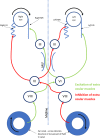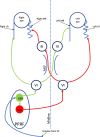Supranuclear eye movements and nystagmus in children: A review of the literature and guide to clinical examination, interpretation of findings and age-appropriate norms
- PMID: 30353137
- PMCID: PMC6367391
- DOI: 10.1038/s41433-018-0216-y
Supranuclear eye movements and nystagmus in children: A review of the literature and guide to clinical examination, interpretation of findings and age-appropriate norms
Abstract
Abnormal eye movements in children, including nystagmus, present a significant challenge to ophthalmologists and other healthcare professionals. Similarly, examination of supranuclear eye movements and nystagmus in children and interpretation of any resulting clinical signs can seem very complex. A structured assessment is often lacking although in many cases, simple clinical observations, combined with a basic understanding of the underlying neurology, can hold the key to clinical diagnosis. As the range of underlying diagnoses for children with abnormal eye movements is broad, recognising clinical patterns and understanding their neurological basis is also imperative for ongoing management. Here, we present a review and best practice guide for a structured, methodical clinical examination of supranuclear eye movements and nystagmus in children, a guide to clinical interpretation and age-appropriate norms. We also detail the more common specific clinical findings and how they should be interpreted and used to guide further management. In summary, this review will encourage clinicians to combine a structured assessment and a logical interpretation of the resulting clinical signs, in order to recognise patterns of presentation and avoid unnecessary investigations and protracted delays in diagnosis and clinical care.
摘要: 目前, 儿童眼球运动障碍已成为眼科医生和医疗保健人员的重大挑战。同样, 对于儿童核上性病变眼球运动的检查和对其产生的相应临床体征的解释也非常复杂。核上性眼球运动障碍主要表现为对称性眼球垂直运动障碍。尽管在许多情况下, 缺乏对疾病系统性评估, 但是简单的临床观察结合对神经病学的初步认识, 仍是临床诊断的关键。由于儿童眼球运动障碍的初步诊断范畴广范, 认识临床分型和了解其神经病学机制对于目前疾病的管理必不可少。在此, 我们提出了针对儿童核上性眼球障碍的系统性、有条理的临床检查综述和最佳实践指南, 适用于不同年龄段核上性眼球运动障碍的患儿。我们还详细介绍了更常见的特定临床发现, 以及如何解释并使用它们进一步指导进行疾病的管理。总之, 这篇综述将指导临床医生将系统性评估病情和临床体征的合理解释结合起来, 以识别临床分型, 避免过度检查和误诊。.
Conflict of interest statement
The authors declare that they have no conflict of interest.
Figures






References
Publication types
MeSH terms
Grants and funding
LinkOut - more resources
Full Text Sources
Medical
Research Materials

